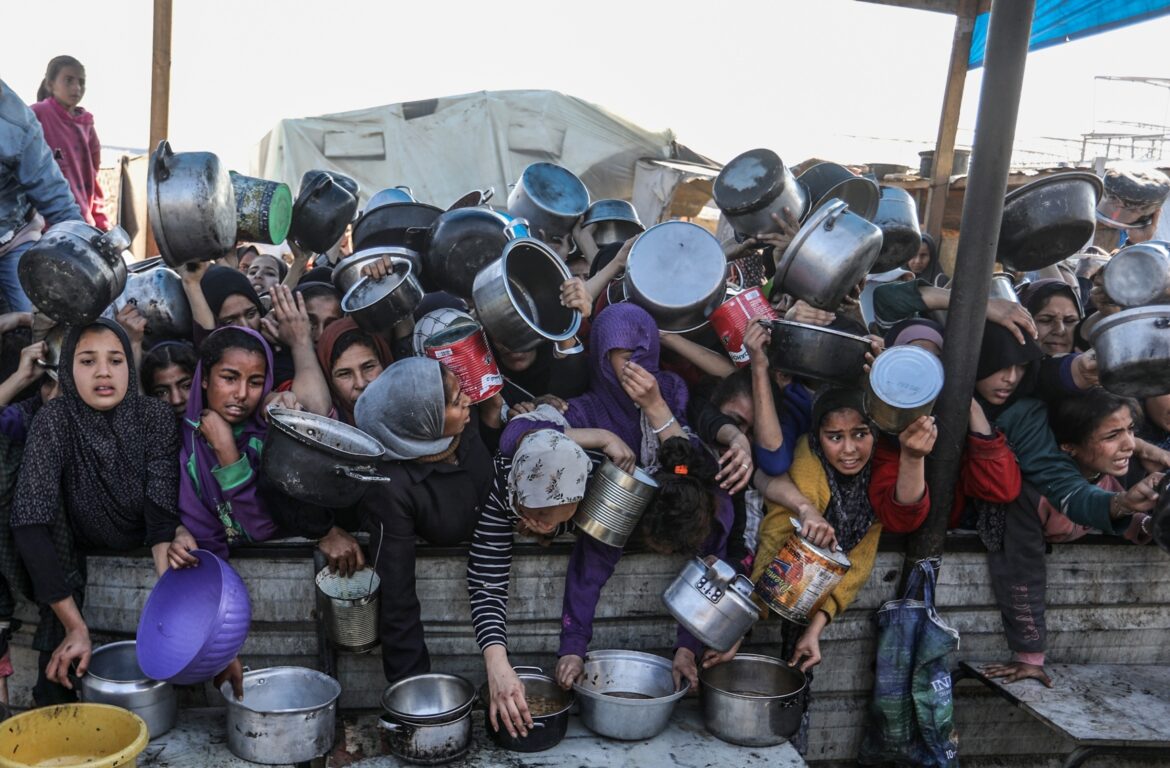Updated August 22, 2025: The Famine Review Committee (FRC) has now officially declared famine in Gaza Governorate, confirming that more than 500,000 people are facing catastrophic food insecurity. The section on Gaza has been updated to reflect this information, including the names of the members of the FRC who were involved in the decision. Oleg Bilukha’s name was removed while Zeina Jamaluddine and Merry Fitzpatrick’s names were added.
In Gaza, hunger has reached crisis levels, with aid agencies warning of a pending famine in the north. Health workers describe the refeeding process for children suffering from severe acute malnutrition, journalists are documenting their starvation, and researchers document how starvation is used as a weapon of war. Between acute food insecurity and formal famine lies a gray zone where malnutrition rates climb, immune systems weaken, and preventable diseases drive mortality.
There’s been no shortage of sharp analysis on Gaza’s yet-to-be-declared famine, which describes the politics and science behind the term “famine.” Famine declarations carry enormous political and humanitarian consequences, such as catalyzing global humanitarian response and intensifying scrutiny of parties to the conflict, yet the individuals making the determination operate largely out of public view.
Clarifying their areas of expertise and tracking institutional continuity aligns with established humanitarian accountability principles, which call for transparency in decision-making and clear identification of responsible actors. Naming the individuals who participate in high-stakes famine decisions also creates a traceable record, as emphasized in famine scholarship for its value to future research and accountability.
The Famine Review Committee (FRC) is a small, ad-hoc, international panel comprised of up to seven independent food security experts convened under the Integrated Food Security Phase Classification (IPC) system, an innovative global initiative activated when a famine classification is proposed or disputed. The FRC was established in 2014 and was originally called the Emergency Review Committee. It analyzes the underlying data, much of it from the Famine Early Warning Systems Network (FEWS NET), the World Food Programme (WFP), and the Food and Agriculture Organization of the United Nations (FAO), to determine whether hunger conditions meet the IPC’s highest thresholds for food scarcity, malnutrition, and mortality. Because starvation of civilians can be prosecuted as a war crime, the FRC’s conclusions carry legal and political weight, making the period before its decision a critical point for accountability.
The IPC scale runs from Phase 1 (“Minimal”) to Phase 5 (“Famine”), with each phase defined by specific indicators, including the percentage of households facing an extreme lack of food, the prevalence of acute malnutrition, and crude death rates. Since its creation, the IPC has declared famine only a handful of times — in Somalia in 2011, South Sudan in 2017 and 2020, and parts of Sudan’s Darfur region in 2024.
These declarations show exactly what the IPC considers to meet the bar for famine, because in other crises with similar conditions, the FRC has withheld a famine classification despite strong evidence provided by field assessments.
Gaza — Not Declared a Famine (2024–2025)
Months of blockades, Israeli airstrikes, and limited humanitarian access have pushed large parts of Gaza into extreme food insecurity. By late 2024, IPC assessments projected that famine was “imminent” in the north, with acute malnutrition and child mortality rising sharply. The FRC has not issued a famine declaration, and its reviews have emphasized the uncertainty of mortality estimates and a lack of convergence across all required indicators. In December 2024, the US pushed for a retraction of the famine warning for north Gaza.
Date of first evidence of famine: March 2024
Days lapsed until official designation: 522 days
Date of official declaration: August 22, 2025
Estimated death toll at time of review: The Famine Review Committee’s report estimates that at least 271 people—including 112 children—have already died from hunger-related causes in Gaza.
Famine Review Committee members at the time of evaluation:
Nicholas Haan, VP & Faculty Chair, Global Grand Challenges and Singularity University
Peter Hailey, Director, Center for Humanitarian Change
Daniel Maxwell, Professor in Food Security, Friedman School of Nutrition Science and Policy Acting Director Feinstein International Center, Tufts University
Andrew Seal, Associate Professor in International Nutrition, Centre for Climate Change, Migration, Conflict, and Health. University College London – Institute for Global Health
Jose Lopez, Chair of IPC Famine Review Committee, IPC Global Programme Manager, IPC Global Support Unit
Merry Fitzpatrick, Research Assistant Professor, Feinstein International Center, Friedman School of Nutrition Science and Policy, Tufts University
Zeina Jamaluddine, Assitant Professor, Faculty of Epidemiology and Population Health, London School of Hygiene & Tropical Medicine
Reasoning summary: The July 29, 2025, IPC alert noted that “two of the three famine thresholds have now been breached”—specifically, the food consumption threshold for famine (Phase 5) and the acute malnutrition threshold. The mortality threshold, however, lacked robust measurement, delaying formal declaration.
Sudan/North Darfur — Declared Famine (2024)
Famine conditions emerged in 2024 as a result of the Sudanese civil war, which began in 2023, primarily in Darfur and Kordofan. The famine was aggravated by the Rapid Support Forces’ (RSF) looting of urban areas and destruction of crops. The Sudanese army further constrained relief efforts by blocking food shipments into RSF-held territory.
Date of first evidence of famine: February 2024
Days lapsed until official designation: 178 Days
Date of official declaration: August 1, 2024
Estimated death toll at declaration: over 1062 total deaths and more than 700,000 children with acute malnutrition. Famine deaths numbered 100 a day as of August 2024. No final count as of yet.
Famine Review Committee members at the time of evaluation:
Oleg Bilukha, Associate Director of Science Emergency Response and Recovery Branch, Center for Global Health/CDC
Nicholas Haan, VP & Faculty Chair, Global Grand Challenges and Singularity University
Daniel Maxwell, Professor in Food Security, Friedman School of Nutrition Science and Policy Acting Director Feinstein International Center, Tufts University
Andrew Seal, Associate Professor in International Nutrition, Centre for Climate Change, Migration, Conflict, and Health. University College London – Institute for Global Health
Jose Lopez, Chair of IPC Famine Review Committee, IPC Global Programme Manager, IPC Global Support Unit
Reasoning summary: The FRC found it “plausible that IPC Phase 5 (Famine) is ongoing in July 2024 in Zamzam camp” and that such conditions were likely to continue into October 2024.
Tigray, Ethiopia — Not Declared a Famine (2021)
Following the outbreak of civil war between forces aligned with the Ethiopian Government and Eritrea and the Tigray People’s Liberation Front in late 2020, large parts of Tigray were cut off from humanitarian access. By mid-2021, FEWS NET and other agencies reported that upwards of 900,000 people in the region faced famine-like conditions, with surveys indicating extreme acute malnutrition in children and widespread crop loss. The FRC reviewed the available data but concluded that insufficient evidence was available to confirm IPC Phase 5 at the required geographic scale. A former UN undersecretary-general for humanitarian affairs went on the record to say that the Ethiopian government ultimately blocked a declaration of famine.
Date of first evidence of famine: November 2020
Days lapsed until official designation: FRC will not declare famine, 1,731 days and counting
Date of official declaration: June 10, 2021. IPC Report fails to declare famine
Estimated death toll at time of review: As of December 2024, starvation remains the leading cause of death in Tigray. Estimates range from tens of thousands to more than 100,000 deaths. According to the UN, at least 400,000 people “had crossed the threshold into famine” by July 2021.
Famine Review Committee members at the time of evaluation:
Oleg Bilukha, Associate Director of Science Emergency Response and Recovery Branch, Center for Global Health/CDC
Nicholas Haan, VP & Faculty Chair, Global Grand Challenges and Singularity University
Peter Hailey, Director, Center for Humanitarian Change
Daniel Maxwell, Professor in Food Security, Friedman School of Nutrition Science and Policy Acting Director Feinstein International Center, Tufts University
Andrew Seal, Associate Professor in International Nutrition, Centre for Climate Change, Migration, Conflict, and Health. University College London – Institute for Global Health
Sophie Chotard, Co-chair of IPC ERC, IPC Global Programme Manager, IPC Global Support Unit
Jose Lopez, Co-chair of IPC Famine Review Committee, IPC Global Programme Manager, IPC Global Support Unit
Reasoning summary: The FRC found the IPC analysis “plausible”, acknowledged widespread human suffering, and warned of “medium to high Risk of Famine” in most scenarios. They stressed that whether the famine threshold was formally crossed was “beside the point,” given “already evident extreme human suffering and humanitarian needs.”
South Sudan — Declared Famine (2017)
In early 2017, years of civil war, economic collapse, and drought coalesced to create acute food insecurity in Unity State, South Sudan, culminating in famine conditions. The IPC declaration took place amid extremely limited humanitarian access, with political entanglements and infrastructural breakdowns hindering data collection and response. The IPC Emergency Review Committee (ERC, later the Famine Review Committee or FRC) validated a famine classification despite incomplete protocol‑level data, using professional judgement under crisis conditions. The humanitarian response in the affected areas after the declaration resulted in the status being lifted by June of that year.
Date of first evidence of famine: June 25, 2015
Days lapsed until official designation: 606 days
Date of official declaration: February 20, 2017
Estimated death toll at declaration: approximately 100,000 deaths by starvation, with more than 1 million children malnourished across South Sudan
Famine Review Committee members at the time of evaluation:
Sophie Chotard, Chair of IPC ERC, IPC Global Programme Manager, IPC Global Support Unit
Peter Hailey, Director, Center for Humanitarian Change
Oleg Bilukha, Associate Director of Science Emergency Response and Recovery Branch, Center for Global Health/CDC
Nicholas Haan, VP & Faculty Chair, Global Grand Challenges and Singularity University
Daniel Maxwell, Professor in Food Security, Friedman School of Nutrition Science and Policy Acting Director Feinstein International Center, Tufts University
Reasoning summary: The FRC acknowledged that the famine declaration was “not in full accordance with the minimal evidence requirements of the IPC standard protocols,” but judged the evidence was sufficient based on professional judgement amid inaccessibility and conflict.
Somalia — Declared Famine (2011)
When a severe multi‑year drought, compounded by conflict, soaring food prices, and restricted humanitarian access under the al‑Shabaab regime, triggered widespread starvation across southern Somalia, humanitarian warnings from the Food Security and Nutrition Analysis Unit (FSNAU), FEWS NET, and IPC went unheeded, delaying action until the UN formally declared famine in two regions in July 2011. Political dynamics, specifically counter‑terrorism constraints, undermined early response despite clear signs of escalating mortality.
Date of first evidence of famine: March 2010
Days elapsed until official designation: approximately 132 days
Date of official declaration: July 20, 2011
Estimated death toll at declaration: approximately 243,600 – 272,700 excess deaths1 across southern/central Somalia during Oct 2010–Apr 2012, with peak excess occurring mid‑late 2011. Almost half of these deaths were children under 5 years old.
Famine Review Committee members: FRC not yet established
Reasoning summary: Confirmed “convergence of evidence” for IPC Phase 5 in two regions (Southern Bakool and Lower Shabelle), citing acute malnutrition rates of more than 30 percent, crude death rate more than 2/10,000 per day, and severe food access constraints.
The FRC is comprised of experienced technical experts, but none of them live under famine conditions. The caution of the FRC members is not cruelty, but its effect is similar: every week spent debating “plausibility” or waiting for statistically airtight mortality counts is another week when people starve. In such conditions, the policy could be simple: feed the children first, discuss thresholds later.
- Excess deaths are typically defined as the difference between the observed numbers of deaths in specific periods and expected numbers of deaths in the same periods. ↩︎


